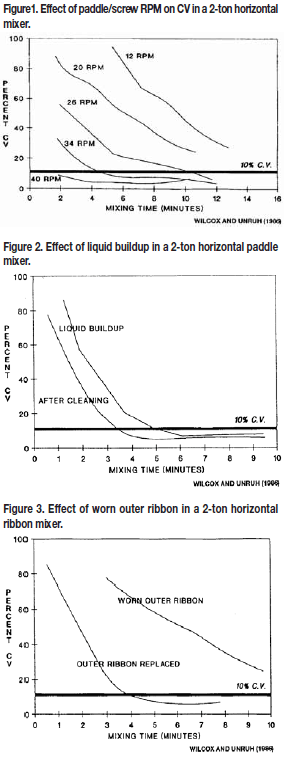Ensuring Optimum Mixability In Feed Manufacturing: Part 3 - Factors That Affect Mixer Performance

Factors That Affect Mixer Performance
Although insufficient mixing time and filling the mixer beyond the rated capacity are often implicated as common sources of variation in finish feed. Other factors such as particle size and shape of the ingredients, ingredient density, static charge, sequence of ingredient addition, worn, altered, or broken equipment, improper mixer adjustment, poor mixer designed, and cleanliness can affect the mixer performance (Wilcox and Balding, 1986; Wicker and Poole, 1991).
The mixing time necessary to produce a homogenous distribution of feed ingredients should be measured for each mixer. Mixing time is a function of mixer design and the rotational speed of the ribbon, paddle, or auger. Each mixer should be "tuned" to its proper Revolutions Per Minute (RPM) for optimum ingredient dispersion. Different types of ingredients may have a different flow pattern within a mixer at similar RPM’s. Generally, (Wilcox and Unruh, 1986), the higher the RPM, the faster the more efficient the pattern of dispersion (Figure 1). However, optimum RPM can change over the life of the mixer resulting from normal wear, ingredient buildup or structure basis to allow the mill operator to make the adjustments needed to achieve a high level of operational performance.
The size uniformity of the various ingredients that comprise the finished feed can directly impact final ingredient dispersion (Herrman and Behnke, 1994). If all the physical properties are relatively the same, then mixing becomes fairly simple. As the physical characteristics of ingredients begin to vary widely, blending and segregation problems are compounded. Large and small particles do not mix well and subject to directional influence in nearly any type of mechanical mixer. For example, ground grain with a particle size of 1,200-1,500 microns reduced the likelihood of uniform incorporation of microingredients compared to grain ground to an average particle size of 700 microns (Herrman and Behnke, 1994).
The sequence of ingredient addition also determines ingredient dispersion in the mixing process (Herrman and Behnke, 1994). Mixers may have dead spots, where small amounts of ingredients may not be readily incorporated into the feed. This situation is exasperated when mixing ribbons, augers, or paddles become worn. Ground grain or soybean meal should be the first ingredient added into a horizontal mixer. It has been determined that for the quickest distribution of the microingredients within the mass of major ingredients, the microingredients should enter the horizontal mixer early in the dumping order, no later than 10 seconds after the first of the major ingredients begins its entry (Lanz, 1992).
Overfilling or under-filling a mixer can lead to inadequate mixing (Wilcox and Balding, 1976). Overfilling a mixer can inhibit the mixing action of ingredients in horizontal mixers at the top of the mixer. Filling a mixer below 50% of its rated capacity may reduce mixing action and is not recommended.
The incorporation of liquid ingredients (fats, oils, molasses, liquid chlorine chloride, Alimet and other liquids) into the mixer is a common practice in many milling operations. The best way to introduce liquid ingredients are through a spray bar installed at the top of the mixer. Dry ingredients should be adequately mixed prior to the introduction of liquids into the system. Premature liquid addition tends to impede the transport of micronutrients and may even agglomerate the fine particles into "snowballs" .
Most engineers agree that multiple points of application (4-8) are necessary to insure adequate dispersion (Lanz, 1992). The preferred location is such that the manifolds are parallel and located on the "up-turning" side of the rotor. Pressure-loaded check valves and air-purged manifolds help minimize the post-spray dripping that can foul the mixer’s rotor.
Ensuring Optimum Mixability In Feed Manufacturing: Part 2 - Effect of Mixing Uniformity on Animals Performance
Ensuring Optimum Mixability In Feed Manufacturing: Part 4 - Mixer Testing
Ensuring Optimum Mixability In Feed Manufacturing: Part 5 - Color-coded Tracers, Data Analysis
Ensuring Optimum Mixability In Feed Manufacturing: Part 6 - Conclusion




